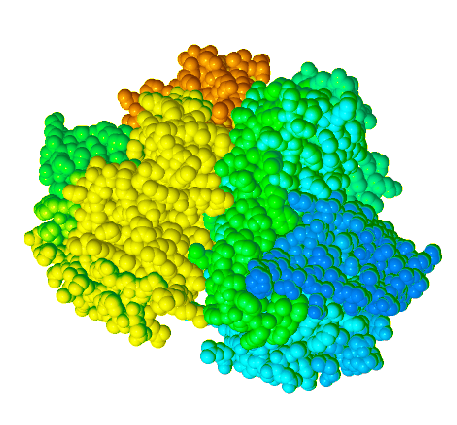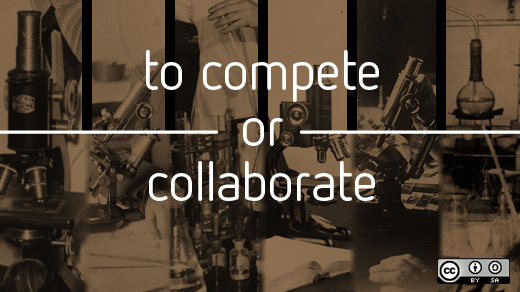In the inaugural issue of the Journal of Open Hardware I review emerging business models for open source hardware. Many of these models are borrowed from the free and open source software industry and will no doubt be familiar to you. However, traditional companies should also take a close look at adding open source hardware to their strategy.
One way a company can start the transition to the open source way is to open source a single product to drive sales of its other products.
A firm can open source the hardware they sell in order to expand the market of other parts of their product line. This is referred to as a secondary supplier model, which is best suited for established companies with more experience and existing patents. I will present an example of this approach used by Nitrate Elimination Company Inc. / Superior Enzymes (NECi), which is primarily a manufacturer of enzymes for green analytical chemistry.
The first recombinant nitrate reductase
Enzymes are proteins that catalyze biological reactions. Enzymes lower energy barriers so reactions occur naturally, in water, without excess heat or pressure. For every chemical reaction that occurs in life, there's an enzyme that specializes in making that process quick and easy. The nitrate reductase from plants—NECi's first enzyme product—reduces nitrate to nitrite, a first step in the chain that turns the elements into proteins and DNA. Because nitrate reductase is in plants naturally, you're eating a healthy diet when you eat them every day. The cleverness of NECi was to use nitrate reductase to replace toxic cadmium reagents for reliable and environmentally benign nitrate measurements.

Figure1. Nitrate reductase space filling model. (GNU FDL 1.3)
NECi was founded to commercialize nitrate reductase, the focus of Dr. W.H. (Bill) Campbell's academic research on plant metabolism. His work was published in Nature (Reduction of nitrate and nitrite in water by immobilized enzymes) and attracted a flurry of press, drew business inquiries, and created a brand-new market for nitrate reductase. Dr. Campbell and Ellen Campbell plunged headlong into the business world in the early 1990s. They released the first recombinant nitrate reductase to the market as a reliable and cost-effective reagent for nitrate detection. Enzyme-based nitrate detection is now a standard method with the U.S. Geological Survey and ASTM International standards body. Although still a relatively small company, NECi's nitrate reductase dominates the biomedical research market for nitric oxide synthase activity kits.
Open source nitrate testing photometer
Perhaps more so here in Michigan than in other parts of the world, we are sensitive to the fact that environmental regulators can sometimes be an inadequate defense of human health from water pollution. There are more pollutants than just lead in Flint's water. For example, intensive agricultural crop fertilization and livestock production often cause harmful levels of nitrate. Nitrate is a threat to human and animal health both directly and indirectly and is thus currently regulated. Government EPA testing, although certainly not perfect in the past, appears likely to be gutted in America's future.
Regardless of your politics, you probably don't want to drink polluted water. One method to make up for the lack of effective government pollution oversight is simply to do it yourself. However, historically the acquisition of reliable and accurate environmental data is not something most people could just go out and do. The equipment is expensive and many of the reagents themselves are dangerous, so you would not want them in your home anyway.
Enter NECi. They developed colorimetric methods for a 1mL cuvette optical bench handheld photometer. Then they collaborated with my lab by open sourcing a new photometer, which radically undercut the cost of other methods to detect nitrates using their nitrate reductase enzymes. By using a combination of the open source Arduino prototyping platform and open source RepRap 3D printing, it is pretty easy to make. Data collection and processing occurs on Android devices for tracking and sharing (Figure 2).

Figure 2. Open source nitrate tester. (GNU FDL 1.3)
For the company's first few runs of commercializing the device, it used freedom-respecting Lulzbot 3D printers and hand soldered the electronics to fit in a nicer package (see Figure 3). In addition to commercializing the photometer themselves, it released the designs under an open license to encourage citizen scientists, makers, and others to fabricate the devices, which would assist in expanding the potential market for their enzymes.
Sadly, standard method status for regulatory compliance under the EPA's Clean Water and Safe Drinking Acts is currently being held up by the chaos of the new administration. Regardless, we showed in a study (Open Source Photometric System for Enzymatic Nitrate Quantification) that a little device you can build yourself for under $65 was just as good as expensive and dangerous nitrate testing in a full-scale lab.
The photometer is gaining traction in the market, thanks to major supplier Environmental Express (now a part of Cole-Parmer) marketing it. The company has a nationwide sales team and is actively marketing the devices and kits. NECi made the first 100 devices by hand and according to them: "We will never try that again."
Making the cases with the Lulzbots, on the other hand, is quite feasible.
In order to scale up, however, NECi found two U.S. companies who specialize in small-scale electronics production and assembly.

Figure 3. The commercial version of the spectrometer. (Image: Courtesy of NECi released under CC-BY-SA.)
Welcome cloners
This is normally where the lawyers would step in and ensure that all intellectual property was locked up for at least 20 years. Because any firm can manufacture open source hardware, the most efficient manufacturer will, in the end, have the lowest price. It is unlikely that NECi, a small enzyme company, will have the least expensive nitrate testing photometer on the market after a few years of international cloning.
NECi is protected from this competition as cloners will drive sales of enzymes, which is its primary revenue stream. Thus, the logic that drives the common fear of cloners is turned on its head. Cloners can actually extend the reach of an open hardware brand and their projects far beyond the original innovators productive capacity. In NECi's case, it directly benefits from increased enzyme sales created by cloners—so cloners, clone away.
In the spirit of making cloning absurdly easy:
- Read the full paper with electronics instructions: Wittbrodt BT, Squires DA, Walbeck J, Campbell E, Campbell WH, Pearce JM. (2015) Open Source Photometric System for Enzymatic Nitrate Quantification. "PLoS ONE" 10(8): e0134989 doi: 10.1371/journal.pone.0134989 open access
- This project is derived from Open source mobile water quality testing platform, in case you want to look at other water properties as well.
- Download STL files for a 3D printing case on YouMagine.com.
- Check out the OpenSCAD code on Appropedia.
- Get the open source software on GitHub.
- Freely download the apps for Android devices on Google Play (sorry, iOS users).
- In addition to water testing, NECi test kits are available for dry forage, green forage, plant petiole, and soil nitrate testing.







Comments are closed.